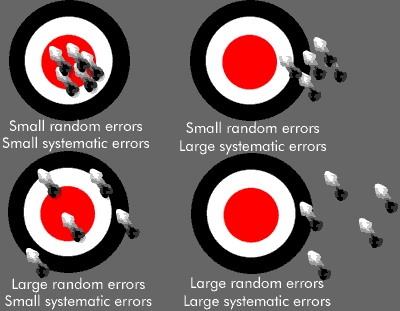- Types of errors
There are two kinds of uncertainty : random and systematic.
Random errors are arbitrary fluctuations in your data. Random errors are easily identified by repeating the measurement. If repeated measurements show that the value is changing every time you measure it, then there are random errors in the experiment.
For example, if you used a stopwatch to measure an event, you might measure 3.45 s in the first trial, 3.25 s in the second, and so on. After many trials you might end up with an average of 3.35 s, but you overestimated the time as much as you underestimated it. Whether or not you overestimate or underestimate on the next trial, however, is totally random.
Systematic errors are errors which skew your data in a particular direction. These cannot be identified by repeated measurements.
For example, suppose the stopwatch in the last example was slow. Then all of your data points are consistently underestimated. Your average with this watch will always be under the actual time elapsed.
Now that you know what type of error you have in your data, let's discuss how to analyze them.
Random errors are arbitrary fluctuations in your data. Random errors are easily identified by repeating the measurement. If repeated measurements show that the value is changing every time you measure it, then there are random errors in the experiment.
For example, if you used a stopwatch to measure an event, you might measure 3.45 s in the first trial, 3.25 s in the second, and so on. After many trials you might end up with an average of 3.35 s, but you overestimated the time as much as you underestimated it. Whether or not you overestimate or underestimate on the next trial, however, is totally random.
Systematic errors are errors which skew your data in a particular direction. These cannot be identified by repeated measurements.
For example, suppose the stopwatch in the last example was slow. Then all of your data points are consistently underestimated. Your average with this watch will always be under the actual time elapsed.
Now that you know what type of error you have in your data, let's discuss how to analyze them.
 Darts example (Taylor, pp. 94-95): Random errors cause the darts to
be widely distributed over the board. Systematic errors cause the darts
to land to one side
Darts example (Taylor, pp. 94-95): Random errors cause the darts to
be widely distributed over the board. Systematic errors cause the darts
to land to one side